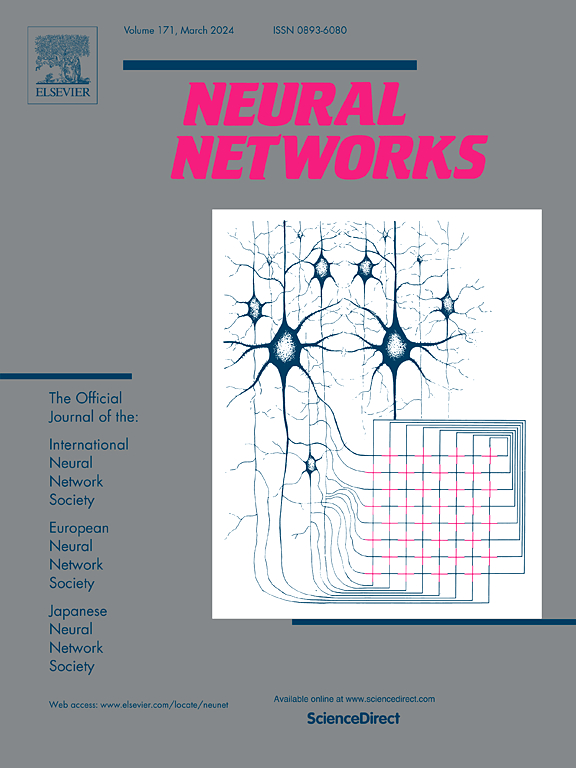基于自适应认知图的多域约束学习系统
IF 6
1区 计算机科学
Q1 COMPUTER SCIENCE, ARTIFICIAL INTELLIGENCE
引用次数: 0
摘要
神经科学研究表明,受外界信息刺激的大脑可以诱发对情绪的功能性反应,这种反应可以通过脑电图(EEG)进行测量和分析。现有的研究大多集中在提取特定的空间拓扑信息和时间依赖表示,少数研究开始挖掘时空跨域信息的价值。然而,这些方法过度依赖于认知先验信息,限制了它们掌握复杂领域结构信息的能力。此外,稳定的认知功能提取对于增强情绪识别系统的性能至关重要。在此,我们提出了一个多领域约束学习系统。它受自适应认知图的启发,将时空表征知识嵌入到构建的框架(AC-DCL)中,以提高情绪识别的性能。在AC-DCL中,精心设计了一个空间引导的动态图约束学习模块,以克服对认知先验的依赖,并自适应地生成和约束认知图中的功能关系。同时,提出了一种时间驱动的序列转换器来提取全局时间依赖特征。此外,本研究还设计了一种新的多领域交互注意模块,该模块具有约束领域特定差异和聚合互补信息的功能,超越了传统的静态跨领域交互。该模型的核心在于从复杂、动态的认知结构中获取稳定的认知功能。在dream、faces和SEED-IV数据集上的实验结果表明,AC-DCL具有令人印象深刻的优势,并具有推动跨域交互表示学习的潜力。本文章由计算机程序翻译,如有差异,请以英文原文为准。
A multi-domain constraint learning system inspired by adaptive cognitive graphs for emotion recognition
Neuroscience shows that the brain stimulated by external information can induce functional responses to emotions, which can be measured and analyzed by electroencephalogram (EEG). Most existing works focus on extracting specific spatial topological information and temporal dependency representations, with a few works begin to mine the value of spatiotemporal cross-domain information. However, these approaches overdependence on cognitive prior information, limiting their ability to grasp complex domain-structured information. Moreover, the stable extraction of cognitive functions is crucial for reinforcing the performance of emotion recognition systems. Here, we propose a multi-domain constraint learning system. It is inspired by adaptive cognitive graphs, embedding spatiotemporal representative knowledge into the constructed framework (AC-DCL) to improve the performance of emotion recognition. In the AC-DCL, a spatial-guided dynamic graph constraint learning module is meticulously designed to overcome reliance on cognitive priors and adaptively generate and constrain functional relationships within cognitive graphs. At the same time, a temporal-driven sequence transformer is proposed to extract global temporal dependency features. Furthermore, this study designs a novel multi-domain interactive attention module with constraining domain-specific differences and aggregating complementary information, which surpasses traditional static cross-domain interactions. The essence of the proposed AC-DCL lies in capturing stable cognitive functions from complex and dynamic cognitive structures. Experimental results on the DREAMER, FACED, and SEED-IV datasets demonstrate the impressive advantages of AC-DCL and its potential to drive the learning of cross-domain interaction representations.
求助全文
通过发布文献求助,成功后即可免费获取论文全文。
去求助
来源期刊

Neural Networks
工程技术-计算机:人工智能
CiteScore
13.90
自引率
7.70%
发文量
425
审稿时长
67 days
期刊介绍:
Neural Networks is a platform that aims to foster an international community of scholars and practitioners interested in neural networks, deep learning, and other approaches to artificial intelligence and machine learning. Our journal invites submissions covering various aspects of neural networks research, from computational neuroscience and cognitive modeling to mathematical analyses and engineering applications. By providing a forum for interdisciplinary discussions between biology and technology, we aim to encourage the development of biologically-inspired artificial intelligence.
 求助内容:
求助内容: 应助结果提醒方式:
应助结果提醒方式:


